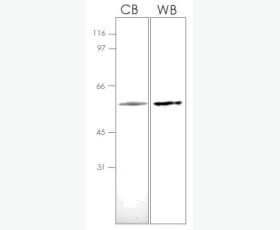Recombinant Human Receptor Expressed in Lymphoid Tissues/RELT/TNFRSF19L
| Product name: | Recombinant Human Receptor Expressed in Lymphoid Tissues/RELT/TNFRSF19L |
| Source: | Human Cells |
| Purity: | Greater than 95% as determined by reducing SDS-PAGE. |
| Buffer Formulation: | Supplied as a 0.2 μm filtered solution of 20mM PB,150mM NaCl,pH7.2. |
| Applications: | Applications:SDS-PAGE; WB; ELISA; IP. |
| Storage: | Avoid repeated freeze/thaw cycles. Store at 2-8 oC for one month. Aliquot and store at -80 oC for 12 months. |
| UOM: | 100ug/50ug/200ug/1mg/1g |
| Source | Human Cells |
| Description | Recombinant Human Receptor Expressed in Lymphoid Tissues is produced by our Mammalian expression system and the target gene encoding Ser26-Ala160 is expressed with a Fc tag at the C-terminus. |
| Names | Tumor necrosis factor receptor superfamily member 19L, TNFRSF19L, Receptor expressed in lymphoid tissues, RELT |
| Accession # | Q969Z4 |
| Formulation | Supplied as a 0.2 μm filtered solution of 20mM PB,150mM NaCl,pH7.2. |
| Shipping |
The product is shipped on dry ice/ice packs. |
| Storage |
Store at < -20°C, stable for 6 months after receipt. Please minimize freeze-thaw cycles. |
| Purity |
Greater than 95% as determined by reducing SDS-PAGE. |
| Endotoxin | Less than 0.1 ng/µg (1 IEU/µg) as determined by LAL test. |
| Amino Acid Sequence |
STTLWQCPPGEEPDLDPGQGTLCRPCPPGTFSAAWGSSPCQPHARCSLWRRLEAQVGMATRDTLC GDCWPGWFGPWGVPRVPCQPCSWAPLGTHGCDEWGRRARRGVEVAAGASSGGETRQPGNGTRAGG PEETAVDDIEGRMDEPKSCDKTHTCPPCPAPELLGGPSVFLFPPKPKDTLMISRTPEVTCVVVDV SHEDPEVKFNWYVDGVEVHNAKTKPREEQYNSTYRVVSVLTVLHQDWLNGKEYKCKVSNKALPAP IEKTISKAKGQPREPQVYTLPPSREEMTKNQVSLTCLVKGFYPSDIAVEWESNGQPENNYKTTPP VLDSDGSFFLYSKLTVDKSRWQQGNVFSCSVMHEALHNHYTQKSLSLSPGK
|
| Background | Tumor necrosis factor receptor superfamily member 19L (TNFRSF19L), also known as Receptor expressed in lymphoid tissues and RELT, is a member of the TNF-receptor superfamily. TNFRSF19L is a single-pass type membrane protein and contains one TNFR-Cys repeat. TNFRSF19L is highly expressed in spleen, lymph node, thymus, peripheral blood leukocytes, bone marrow and fetal liver. It has been shown TNFRSF19L activates the NF-kappaB pathway and selectively binds TNF receptor-associated factor 1 (TRAF1). TNFRSF19L is capable of stimulating T-cell proliferation in the presence of CD3 signaling, which suggests its regulatory role in immune response. |














